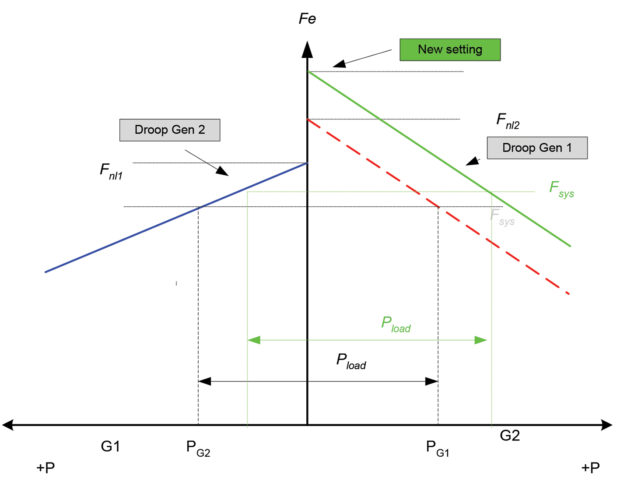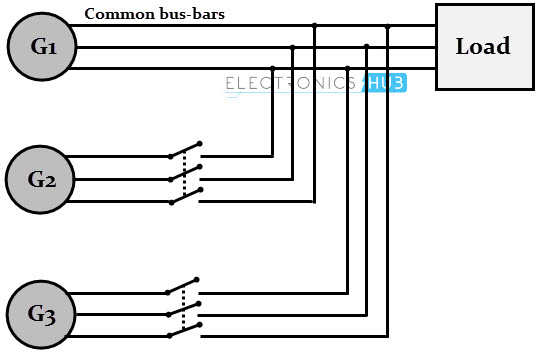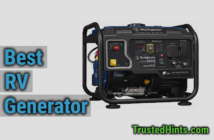Whenever you need more power, connecting two generators in parallel is always a great idea.
However, this process is not as easy as you think, and it involves many delicate steps. So in this article, I am going to talk about, what is paralleling a generator, why do you need it, and how to successfully connect two different generators in parallel.
What is paralleling generators?
Paralleling generators or running generators in parallel means that simply connect two generators in parallel to double the power output. Generally, it is easier to connect the generators having the same power output or the same brand generators together.
If your generator is parallel capable, then it will be much easier to connect them parallelly; however, if your portable inverter generator is not parallel capable, then the procedure is a little different. We have explained the method of connecting two generators in parallel below, so keep reading.
Moreover, you would need a suitable parallel kit as well as wires that can easily carry the power generated by both generators.
Looking for Best Paralleling Generators? Check out our Reviews of Best Inverter Generators (With In-depth Comparision of power output, noise output, runtime, and much more)
Can you parallel two non-inverter generators?
Technically, you can parallel two non-inverter generators using a tiebreaker and a voltmeter. You have to phase match and sync both non-inverter generators. But you will not get 100% output and the procedure is very difficult and any mistake can damage the generators.
The main problem is that the waveforms of both non-inverter generators might not be in sync when you parallel both generators so as a result, the connected generator will overload. Therefore, I would advise you not to connect the two non-inverter generators in parallel or any non-inverter generator with the inverter generator.
On the other hand, the inverter generators communicate via frequency and sync with each other. They can even increase and decrease power output according to load demand.
Can you parallel two different brand/size generators?
Yes, you can parallel two different brand/size generators and the paralleling process will become easier if both the generators are parallel capable. Please note that both generators should be inverter type for the successful parallel operation.
Now if both are parallel capable, then with the help of a parallel kit you can connect them. Any parallel kit comes with six terminal; four are power connectors whereas the rest two are ground cables which you need to connect with the ground of the generator. You can check out this video to understand the same.
Here’s the link for the Firman 1201 Parallel Kit. You can also use the WEN Parallel Kit.
Now in case if any one of the two generators is not parallel capable or both the generators are non-parallel, then here’s the procedure of connecting them in parallel.
First, you need to connect the output port of the one generator (generator without non-parallel capability) to the input of the other generator and then connect the appliance to the second generator. After that start the non-parallel generator first and then start the parallel-capable generator.
So now you have successfully connected two different brand generators or two different size generators together. The below video also explains the same paralleling procedure.
How to connect generators in parallel?
First of all, you need to make sure that both of your generators are parallel capable. Now, if both the generators are the same models, then the paralleling process will become much easier and efficient.
For different generators, we have described the paralleling process later in this article, so don’t forget to check that out.
You can either use a parallel kit or parallel cable as you see fit. The parallel kit is a lot easier to use and doesn’t require any learning curve.
The parallel kit has six leads of which four are power connectors and two are ground connectors. Now if there is a plus-minus sign described on the parallel port of the generator then you have to read the manual of the parallel kit to connect them carefully and also don’t forget to connect the ground ports to the generator.
As you know, not many generators come with parallel capability, but instead, only mid-size and small-size generators come with this feature.
You will be happy to know that you don’t have to monitor or control the power of each generator; here’s how. If your generator is parallel capable, then it will automatically increase or decrease the power production according to power demand, which is a huge advantage.
Does paralleling cause damage to those generators?
The generators designed to run in parallel will not be harmed as long as you use the right size cables. Also, don’t forget to follow the instructions provided by the manufacturer to prevent any damage to the generator as well as your appliances. That being said, check out the best dual-fuel generators available in today’s market.
Why run generators in parallel?
We live in a world where we are so dependent on electricity that we cannot live without it.
Sometimes your generator is not enough to meet your power demands, but you need additional power to run your appliances like AC, refrigerator, and microwave. At that time, you have only one option, which is to run generators in parallel, and thus you can increase the power output.
To figure out what generator you need, check out this sizing guide and calculator.
Read Also,
Why not just buy a larger generator?
There are so many reasons not to buy one bigger generator. First of all, you might already have a medium or small generator, but if you still need additional power, then buying a bigger generator is not an option. Instead, you can buy the same model and then connect those two generators together to get the required power.
Only portable generators come with high power-producing capacity, and they are not as fuel-efficient and quiet as inverter generators, so that is why you should avoid buying one big generator. So it is safe to say that inverter generators are superior to conventional generators in every aspect.
Also, if the big generator fails, then you will not be able to run any electrical device at all. But on the other hand, if you are using two parallel capable generators and even if one of them fails, you will be able to run at least basic appliances, which is a huge advantage.
Another reason is that you cannot carry a big generator everywhere, and sometimes if you want to use the generator for camping or other outdoor activities, then a small inverter generator will be sufficient rather one bulky generator.
What is the load sharing of a generator?


When generators run in parallel, the load of the electrical device is equally distributed between them, which is known as load sharing of the generator. Sometimes it is also referred to as the proportional division of KVAR (Kilo Volt Ampere Reactive) and kW when calculating the load sharing.
To avoid stress on the generator, the load is always equally shared between two generators, and it is monitored through an advanced system. Now, as the load demand increases, both the generators will equally burn more fuel to match the demand; thus, you will avoid problems like instability and overloading.
There are many methods by using which you can equal load sharing. Here we are going to look at the Isochronous kW and kVAR Load Sharing method. In this method, the speed governor of the individual parallel connected generators determines the proportional share of active power required by the system. And by decreasing or increasing the fuel supplied to the engine, you can achieve the KW load sharing.
What is synchronization?


Whenever you connect two generators in parallel, they must be synchronized in order to use the generated power, and if they are not synchronized, then the generator and your appliances both will get damaged.
In synchronization frequency, phase, and voltage of all the generators must match.
How to synchronize generators when connecting in parallel?
If more than two generators are connected in parallel, then you need to satisfy some conditions, especially when the generators are not parallel capable.
- Waveform: Waveforms of both the generator should be a sine wave
- Phase Sequence: In the case of a three-phase power supply, you need to make sure that the phase sequence of both generators is in correct order meaning that the voltage peak on the sine waveform must match.
- Phase Angle Difference: The difference in phase angle between two sine waves should be zero if you are using a three-phase system.
- Voltage Amplitude difference: The sine wave voltage peaks must match, which means that both the generators should produce the same voltage level.
Factors You Need to Consider for Paralleling Generators
Generally, people connect two generators of the same brand and same power level to avoid any compatibility issue, but this doesn’t mean that you cannot connect two different brands or two different size generators together.
A general rule of thumb is that both the generators can be connected together as long as the voltage and frequency at the point of connection is the same. Whenever you connect two different generators together, you need to check the compatibility of engine & alternators, load sharing, and interface compatibility.
1. Engine compatibility
The engine capacity of the generator is measured in KW (kilowatts). It is important to run the generators having the same KW as possible to prevent any system overload as well as to operate the higher loads. For example, one generator is rated for 400KW, and the second generator is rated for 200KW, then you will be able to run any load up to only 200KW. So the load supplying capacity solely depends on the power-producing capacity of a smaller generator.
2. Alternator compatibility
Alternators of connected generators are compatible as long as currents between them don’t flow in each other’s circuits. There are protecting relays placed inside the alternator to prevent this situation, but sometimes it can affect the generator’s operation.
Now the generator with lower frequency will act as a load to the other generator, and this phenomenon is known as motoring and it can overload both the generators as well as fail the entire system.
3. Load sharing system compatibility
As I said earlier, the voltage and frequency of both the generators must match, and once this setup is arranged, you can no longer monitor the voltage or current to balance the output power. Any unbalanced output/power will result in an uneven distribution of reactive load between two generators.
4. Interface compatibility
When the first parallel process was used, all the generators need to be manned all day and operated manually during every process. But today’s generators communicate with each other automatically during the whole paralleling process to maintain continuous operation. So all the parallel-connected generators must have a clear line of communication.





17 Comments
I have 2 inverter generators of different manufacturers. Both are 2000 watt.
Models are… Champion model 100565 and Powerhorse model 42411.
I would like to parallel them and connect to a transfer switch. They are both parallel capable. The powerhorse came with a parallel cable; however, the champion requires a “parallel kit”. Both gens have parallel operation outlets; however, only the Powerhorse has a L5-30 outlet. Am I correct in thinking the need for the parallel kit is to provide the 30 amp outlet (which the Powerhorse already has)? The other issue is that the parallel cable provided with the Powerhorse has round plugs while the outlets on the Champion are square. If I manage to modify the cable to parallel the 2 gens, will it work? And, if so, what would you recommend for supplies to accomplish this (transfer kit, cable,etc.)?
Thank you,
Bob L
Bob poses a good question, and remains unanswered.
At first, I was replying to every comment through email but now I have decided to replay them here. I hope you find your answer.
Yes, the parallel kit is used to provide the 30-amp outlet. Because as the power of both the generators combine the current output increases, which is why a high amperage cord is needed.
Since both your generators are rated for 2000-watts, the 30-amp parallel kit will be enough. If you convert round plug to square once, then the paralleling will definitely work.
It will be much better if you connect it to the transfer switch. So this way if you overload the generator, it will simply stop. But make sure you make the right connections including ground connection.
I hope it helps.
can you intentionly shut one generator down without damage to the other one when you only need them both for the starting load of an airconditioner.
Yes, you can shut one generator without damaging the other one.
How do you hook up a second gas tsnk with the cap to your generator
This thread may help you solve your problem. https://www.doityourself.com/forum/outdoor-gasoline-electric-powered-equipment-small-engines/398861-auxiliary-gas-tank-generator-how-add.html
I have a bond 2000i eu generator. I’m very new to RV’ing and want to use it. My rv takes 30amps to produce AC. Is there a cheaper investor generator that a can parallel my Honda to to use AC? I have the Honda cables.
Thanks!
There are many cheap inverter generators available on the market. We advise you to check out our reviews of best inverter generator for more information.
Can anyone comment on whether is possible to connect a parallel-ready generator to a solar system. Specifically, take the DC power output from the solar charge controller and run it into the generator’s inverter to product AC power, with or without the generator running?
Some details on this… Why? What’s the application? I’m finding that a really good DC to AC inverter is about the same cost of a decent inverter generator of similar wattage. If my battery bank is low or the load increases, and I need to run critical appliances, I would like to turn the generator on to maintain power without a bunch of switching power cables from Solar to Generator. Since the inverter generator is already inverting DC to AC, it would be great to have 1 less piece of equipment and use the generator’s inverter with the DC output of the Solar charge controller.
Hello Moderator – Its disappointing that my comment is not being allowed. Why?
Hi there, Tim.
First of all, I would like to clarify that you cannot connect the solar panel’s output to the inverter generator because there is no input connection and it is securely enclosed in a generator.
By DC to AC inverter, I assume that you are referring to a solar generator or portable power station. It is priced the same as an inverter generator due to the high cost of the internal lithium-ion battery, powerful inverter and MPPt charge controllers.
Inverter generator and portable power station are both totally different things, and you cannot just connect one’s output to the other’s input.
If you cannot run critical appliances through the portable power station, then I would suggest you buy one big inverter generator, which you can find here.
If you are running a high power-drawing appliance all the time through a generator, then I would not advise using the portable power station because of its less running power and storage capacity.
If you have any further question, please let me know.
I have two Honda 2000 kw generators thi I normally run in parallel for my camper. However, when I need the second a/c unit, the generators won’t handle the load. Is it possible to buy a third Honda generator same rating and connect all three in parallel and have a 50 amp output vice 30 amp with the two in current configuration?
Yes, you can connect three generators in parallel using the configuration shown in this video. https://www.youtube.com/watch?v=JklXAbCAfRM
As shown in the video, you have to use the parallel kit and connect two generators using the parallel kit and connect the thrid’s output to the parallel kit and you are good to go. For additional information, you can also check out this video. https://www.youtube.com/watch?v=bbvHjX1Of4g
I have a coleman powermate 6875 it is a straight generator I am in Lake Charles LA affected severely by the storm. My 5th wheel has two AC units that are connected and start together. This draws more amps/watts than my generator will provide. I wanted to connect two generators together. I have a 50amp connection 1 ac runs on 1 pole and the other AC runs off the other pole. Can I connect 1 generator to each pole? will that work without running them in parallel? desperate.
Inverter generators can easily run in parallel and increase/decrease power output according to the load demand. They communicate with each other so they run in sync. However, using them to run AC unit without paralleling would not be a great idea.